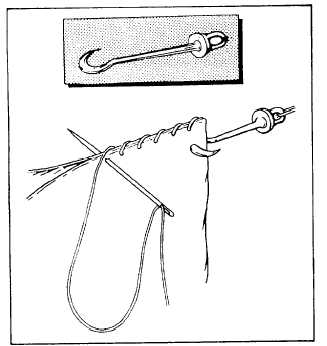| |
SEWING CANVAS BY HAND
When you are required to fabricate articles, you will
need the appropriate tools. Some of the tools used for
fabricating are listed below.
Sail needles: Needles are numbered according to
size; the higher the number, the smaller the needle. The
heavier the canvas, the larger your needle should be.
After use, needles should be dried carefully and oiled or
stowed in a container of powdered chalk to prevent them
from rusting.
Palms: Two types of palms are issued in the
Navy: the sailmaker's palm and the roping palm. At first
glance you probably see no difference, but if you check
the metal slug you can see that the roping palm is
designed for larger size needles. This is the palm to use
when jobs require the largest needles-sewing on bolt
ropes, for example.
Sailmaker's or bench hook: This hook has a
swivel eye. It is used to hold the ends of two pieces of
canvas being sewn together, as shown in figure 3-34.
Beeswax: This substance can hardly be called a
tool, but it is a necessary item. It reduces the wear on the
sail twine while sewing and retards deterioration.
Sail twine: Many different types of twine are
used for sewing, mostly cotton; but lacing twine
(already waxed) is best for sewing by hand.
Stitches and Their Uses
Here are some of the common stitches that you will
find useful in your work.
Round stitch: The round stitch is the one used
most commonly for joining two pieces of canvas. Turn
back the edges, hold the pieces together, and send the
needle through both pieces at right angles at the seam,
as shown in figure 3-34.
Flat stitch: A flat stitch is used when a strong
seam is required, as on a paulin or a sail. Pencil a
guideline 1 1/2 or 2 inches from the edge of each strip
of canvas, depending on how wide you want the seam.
Crease each piece on a line slightly less than halfway to
the guideline. Make the folds away from the guidelines
and interlock the folds away from the guidelines and
interlock the folds (fig. 3-35). Interlocking the edges
forms a watertight seam and keeps a ragged edge from
showing. Insert the needle at the guideline, and stitch
diagonally so that stitches appear at right angles to the
seam on top but run at an angle on the reverse side. After
completing one edge, turn the canvas over and sew the
other edge of the seam. Flat stitching also is used for
patching.
Baseball stitch: The baseball stitch is used to
mend tears in light and medium canvas. Figure 3-36
shows how it is done.
Herringbone stitch: The herringbone stitch is
used to mend tears in heavy or painted canvas. Figure
3-37 shows the steps in making this stitch.
Figure 3-35.–Flat stitch.
Figure 3-34.–Round stitching canvas held by a bench hook.
3-26
|


